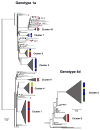Evidence of a large, international network of HCV transmission in HIV-positive men who have sex with men
- PMID: 19422083
- PMCID: PMC4260925
- DOI: 10.1053/j.gastro.2009.02.006
Evidence of a large, international network of HCV transmission in HIV-positive men who have sex with men
Abstract
Background & aims: Since 2000, there has been a marked rise in acute hepatitis C virus (HCV) in human immunodeficiency virus (HIV)-positive men who have sex with men (MSM). We conducted an international phylogenetic study to investigate the existence of an HCV transmission network among MSM.
Methods: HIV-positive MSM diagnosed with recent HCV (n = 226) in England (107), The Netherlands (58), France (12), Germany (25), and Australia (24) between 2000 and 2006 were enrolled into a molecular phylogenetic study. Using real-time polymerase chain reaction (PCR), the NS5B region of the HCV genome (436 base pair) was amplified, sequenced, and compared with unrelated NS5B sequences.
Results: NS5B sequences were obtained from 200 (89%) cases. Circulating HCV genotypes were 1a (59%), 4d (23%), 3a (11%), 1b (5%), and 2b/c (3%). Phylogenetic analysis revealed 156 (78%) sequences that formed 11 clusters (bootstrap value > 70%) containing between 4 and 37 individual sequences. Country mixing was associated with larger cluster size (17 vs 4.5 sequences; P = .03). "Molecular clock" analysis indicated that the majority (85%) of transmissions occurred since 1996.
Conclusions: Phylogenetic analysis revealed a large international network of HCV transmission among HIV-positive MSM. The rapid spread of HCV among neighboring countries is supported by the large proportion (74%) of European MSM infected with an HCV strain co-circulating in multiple European countries, the low evolutionary distances among HCV isolates from different countries, and the trend toward increased country mixing with increasing cluster size. Temporally, this epidemic coincides with the introduction of highly active antiretroviral therapy and associated increases in sexual risk behaviors. International collaborative public health efforts are needed to mitigate HCV transmission among this population.
Figures
References
-
- Gotz HM, van Doornum G, Niesters HG, den Hollander JG, Thio HB, de Zwart O. A cluster of acute hepatitis C virus infection among men who have sex with men--results from contact tracing and public health implications. AIDS. 2005;19:969–74. - PubMed
-
- Danta M, Brown D, Bhagani S, Pybus OG, Sabin CA, Nelson M, et al. Recent epidemic of acute hepatitis C virus in HIV-positive men who have sex with men linked to high-risk sexual behaviours. AIDS. 2007;21:983–91. - PubMed
-
- Serpaggi J, Chaix ML, Batisse D, Dupont C, Vallet-Pichard A, Fontaine H, et al. Sexually transmitted acute infection with a clustered genotype 4 hepatitis C virus in HIV-1-infected men and inefficacy of early antiviral therapy. AIDS. 2006;20:233–40. - PubMed
-
- Bateman KM, Factor S, Gutierrez JA, Fierer DS, Uriel AJ, Carriero DC, et al. Evidence for sexual transmission ofhepatitis C virus infection in men who have sex with men (MSM) in New York City. 14th International Symposium on Hepatitis C Virus and related Viruses; 9-13th September; Glasgow. 2007. abstract P48.
Publication types
MeSH terms
Grants and funding
LinkOut - more resources
Full Text Sources
Other Literature Sources
Medical


 ) England, (
) England, ( ) Netherlands, (
) Netherlands, ( ) Germany, (
) Germany, ( ) France, (
) France, ( ) Australia. Australian MSM with reported IDU are marked IDU*
) Australia. Australian MSM with reported IDU are marked IDU*